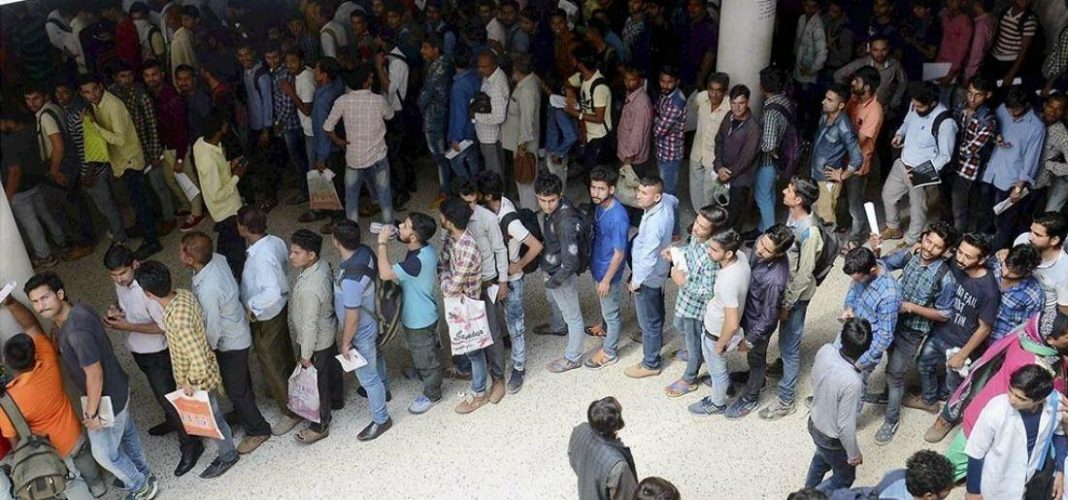NSSO’s recently leaked report of India facing the highest unemployment in 46 years of 6.1%, as given by Business Standard of January 31, 2019, has had the opposition parties, wasting no time in raising the election bugle, on citing this as inability of the Government. The Government, on a back foot, seems to be underplaying the report as not officially approved. It has cited change in methodology, infirmities in the data etc. The political rhetoric seems to have pushed this critical issue to ascending heights.
Be as it may, it has certainly established unemployment as a central issue for the forthcoming elections. Economists and intellectuals should have debated NSSO reports on purely technical ground discussing its methodology, data accuracy, implications and other such grounds. The deafening silence on this once again highlights the fear amongst economists and intelligentsia of voicing their opinions against the government for the fear of reprisals and vindictiveness.
Unemployment issue is too serious to let it be subjected to political rhetoric. Unemployment is a global phenomenon and numerous prestigious studies indicate the severity of the issue. More importantly, the impact of Technology in the coming years is rendering even the existing jobs surplus. Even in countries like India, nearly 70% of the jobs can be rendered surplus even by existing technologies. The technological scenario worldwide, is very disruptive and even the present technologies will pale into insignificance.
India has been priding its demographic dividend as an asset. The new technologies demand a shift to higher skills to displace lower skills. For India to be benefit from the opportunities of the future, they have to focus on education, upskilling and most importantly its attitudes and work ethos. So, the debates need to hover around how we can address this important issue than playing the blame games.
The crude reality is that India has the numbers but not the quality needed for future jobs. Solutions are not easy and require not only strategic approach but a well thought out plan of action that the nation should work towards. India needs a dual strategy in addressing the placement of its citizens global opportunities as well as creating jobs for its low skilled majority population to meet its challenge.
Speed of Developmental Agenda is a key issue:
UNEMPLOYMENT is the single biggest challenge faced by Indians in the 21st century. There is a need to focus on growth that will create prosperity and generate employment for its youth. India is characterized by the having over 46% employed in Agriculture. In the unorganized sector, majority of the people are self-employed. Unorganized, small sector employ over 93% of the non-agricultural labour force in the country. All these jobs are low skilled jobs.
Strategic approach to resolving unemployment:
The country needs to embrace growth and productivity for job creation. Automation plays an important role in this. There is sufficient evidence that technology will create additional jobs in new areas that do not presently exist. The country can take advantage of its “population dividend” by adopting a dual differentiated strategy for its talented pool to serve the global opportunities as well as deploy the “population dividend” to create low skill domestic jobs in tourism, healthcare, construction and other labour intensive sectors.
LEVERAGING INTERNATIONAL MARKET OPPORTUNITIES FOR INDIAN HIGH SKILLED WORKFORCE
There are two approaches to addressing this segment, namely:
- Embrace digitization of industry and create “island of excellence”
India needs to encourage its industry to shun labour arbitrage businesses and focus on becoming internationally competitive in quality and price. This requires a focused approach in building a team India approach by adopting digitization of industry, which does not cost much. It has more to do with the top down management approach and change of work ethos than to do with technology. This could be achieved by incentivizing well-established Indian companies who have demonstrated this skill, to adopt other companies and be rewarded a percentage of the profitable share due to improvements. This will build not only the industrial culture but also teamwork needed to compete internationally. There is a need to create islands of excellence with the latest infrastructure not only to ensure there is no brain drain but to attract people who could add value on the way forward.
- Prepare India to be the preferred source of skilled value adding world labour force:
India has the “population dividend” advantage as most of the countries are experiencing labour shortage in future. However, India can only play to its advantage if its labour skills are in tune with the international requirements. As recorded above, globally as of 2017 nearly 1.4bn workers are expected to be in vulnerable jobs that could be lost. Automation requires higher skills, an area where Indian professionals have already earned a good reputation. So, global opportunities can be a huge potential for Indian job seekers but the present skills need to be upgraded. There is a need to provide tax incentives to the Universities and Corporates to invest in high skill training. There is a need to selectively identify potential talented people and provide special training by giving incentives to the training institutions. In collaboration with the industry, there is a need to develop curriculum to ensure that the future required skills are imparted.
According to the Indian Employment Report by IMA, there were 6.3 Mn graduates and 1.4 Mn post graduates in 2016. Most of the existing employed and these people need to be up skilled to be qualified for the new jobs.
Indian skilled workforce suffers from their ability in problem solving, work ethos, team work, relationship management, attitudes, innovative / critical thinking, curiosity and other factors that are going to be the driving force for the future jobs. Therefore, there is an urgent need to have a national agenda for focusing the existing graduates and those joining the work force to reequip themselves.
Train Indian graduates to foreign languages:
To be a key player in the international sphere, it is advisable to equip Indian graduates with foreign languages. It needs to provide a stipend for people learning foreign languages either to the students or foreign language teaching institutions
Providing transitionary support:
The future is typified by chaos and lay offs will be the order of the day. Therefore, there is a need to protect the Indian workforce between jobs by providing transition support for highly skilled people to cope with job losses due to technology for a period of six months provided they undergo retraining in the new skills. However, one should avoid the pitfalls of the schemes being based on entitlement instead of being based on creativity and entrepreneurial efforts.
Government must undertake periodic 6 monthly Certification Programs
Quality is more important that quantity. Foreign workforce has many advantages including superior ecosystems over their Indian counterparts. To keep pace with them, India has to, as a minimum, maintain high international Standards. To do so, Government must undertake periodic Certification exams. If India is able to keep the quality focus of the certified workforce, it will have a multiplier effect.Adopting the German model of providing intensive vocational training in areas like elderly care, health care, vocational trades kind of traits that will be useful to get international jobs
Provide a platform for online learning:
Innovative ideas and confidence comes from exposure to ideas, data and videos of international quality. Public financing for providing free access to a plethora of videos and datas like Ted talks, innovation channels, ideas, reports etc. must be undertaken. This will provide anecosystem for potential entrepreneurs and also for graduates to get exposed to practical applications of their theoretical knowledge.Government will have to subscribe to various libraries, conferences and databases to build an online library for this purpose and make it available to the Public free of cost. There are a number of technology platforms for self-learning skills and curriculums. A comprehensive study of these have to be made and databases built on a portal that can be freely available to all.
Provide access to capital especially to MSME & Unorganised sector:
The bane of most of the small enterprises and entrepreneurs is the paucity of initial funds to test the concepts. This is critical if we have to create an ecosystem for the nation. Government efforts to provide miniscule seed capital neither serves the purpose nor its effectiveness. Moreover, the government does not have the expertise.The Public exchequer should promote (a number of forums that will organize) fortnightly “entrepreneurship melas” where potential business investors and “potential entrepreneurs” can meet to foster interactions and startup partnerships. The businessmen should be held accountable for guiding the potential entrepreneurs and be given an opportunity of investing in the startup. A matching Public funded grant should be given to the startup effort. In addition, businesses should be given a tax exemption on the investments they make in the startup venture. To prevent misuse, a number of factors need to be outlined and put upfront in consultation with the stakeholders.
Providing mentoring to graduates:
There are a number of soft skills that need to be imparted. Publicly financed exercise will need to be undertaken to form large database of retired people and those in the industry who would want to volunteer. Computerized mentoring matching can help put people based on geographic locations, interests, skills etc. Training centers will need to provide certification on completion. Mentors could be given 1% tax exemption off their taxable income. For people who do not have taxable income (retired people), concessions on power bills etc. can be provided.
Make it mandatory for Multinationals operating in the country to take apprentice:
The best training and culture of international standards can mostly be provided by MNCs. Government must put the onus on the MNCs to provide a three to six month apprentice program to people in various areas. Public funds will provide for the trainee stipend and the MNCs have to fund the rest.
Provide incentives for NRIs residing abroad to mentor and train assigned people online:
For effectiveness, ”exposure” plays a crucial role. Indians have limited exposure to the state of the art developments around the world. Video conferencing/Skype facilities make it easy for communications. Government should make Video conferencing available thru kiosks for graduates free of costs. NRIs who successfully train for more than prescribed hours could be given one week free holiday during their Indian Visit. This will thus tap nearly 1 million plus trainers at very low cost for providing exposure &upskilling exercise.
Placement Services abroad for graduates:
There is a need for Government to set up a huge database network to provide online matching of potential jobs around the world and the Indian job seekers. For this, all the Indian embassies abroad must be mandated to enable linkages to (sell the concept of mutual advantage) organizations where potential jobs being made available. Indian Government will have to build credibility of the job seeker data provided by undertaking screening the potential candidates and testifying to the accuracy of the degrees etc. to the foreign employers. Likewise, the embassies will need to establish the authenticity of the business organizations providing jobs. An incentive program should be developed for the employers to prefer Indians. There can be concerns of “encouraging brain drain” but in reality, Indians cannot absorb most of the talent. Moreover, Indian companies need to compete internationally and hence this argument does not merit consideration.
Allow only Conglomerates with investment of over Rs 100 crores to export:
One of the fundamental requirements of creating jobs is to export products from India.. However, India’s exports have remained very low and needs to be target to over 15% market share. World over, it is the MSME that provide for majority of the export production but the marketing and branding have been undertaken by large organizations. This model has proven success for most countries Japan, South Koera, China etc.
Exports require heavy investments and should not be left to small players. Only few select large Companies with investments in excess of Rs 300 crores should be allowed to export and be held accountable for maintaining quality, branding and service. Their profit margins must be fixed so that they do not exploit their vendors. These export houses will provide the much needed investments in marketing, working capital funding, ensure quality control and provide technological & managerial help to the suppliers etc. Tapping the export markets will generate not only the, much needed, foreign exchange but will help create significant jobs in the country.
Reimagining Education:
There is a huge skill mismatch in the Indian Educational System. Employability of people even from the premier educational institutions is low around 6-10% forcing companies to retrain. Therefore, there is a need to reimagine the educational curriculum. More serious problem is the lack of good academic training staff.There is an urgent need to revamp the curriculum to focus on higher skill requirements of the future, expose the students to more pragmatic approach to problem solving skills, emphasize on soft skills of teamwork, creative thinking, good work ethos, social and emotional skills, communications, ability to self learn lifelong etc.
Changing the Educational Curriculum and practices:
For longer term, there is a need for paradigm shift in our educational content and style. Indians have demonstrated competence and knowledge but lack Emotional Quotient. They shy away from taking initiatives & look forward to being given instructions, as they are risk averse. They do not make good team players and attitudes need significant change. These are the skills that will fetch premiums in future. Therefore, there is a need to incorporate soft skill training into the academic curriculums, encourage risk taking, teamwork etc. Enough free material is available but considerable skill training modules need to be prepared and imparted.
Shake up the job protection for non performing teachers:
Our Schools are where the strong foundations can be laid. The Public financed schools have highly qualified teachers that are not performing. Job protection and the needless bureaucratic interference in schools vitiate the environment. Government must enforce merit and performance based pay and job tenure. Schools must be allowed to remove teachers that are not committed or are incompetent. It must help schools improve their teacher performance. India’s model of private education at the cost of public education has been counter productive and has increased the cost of education. Delhi Government has demonstrated that Public Schools, run efficiently, can produce as good or better results than private schools. There must emphasis on better quality public school system and commercialization of Education discouraged.
Most of the private sector Institutes are not adequately staffed and are not imparting high quality education. Equally, teachers are over burdened and have to be relieved of their administrative functions. The local panchayats should provide these functions by encouraging their community members to volunteer or raise funds locally for providing the administrative function. Defaulters must be subjected to severe punitive action that can set examples.
Capitation and Reservation systems have run their life and must be replaced with merit oriented admissions. Special classes and special attention to laggards would serve to improve the quality of output.
Tele-education must be leveraged to augment teacher skills & infrastructural limitations of schools and universities to impart quality education and exposure to labs etc. To make this paradigm shift, Government must tap ILO, UNISEF and other donor countries to provide international resources on training the existing staff on teaching methodology and assist with developing new curriculum.
JOB CREATION IN INDIA FOR THE LOW SKILLED JOBS:
Bulk of the workforce in India will remain low tech for the near future. It is critical for the country to provide for jobs. There are four to five key sectors that account for major employment for its citizens- the single biggest being agriculture.According to the 2015-16 Ministry of Labour Survey on unemployment, 46.1% of the employment is in the Agricultural sector; 32% in the tertiary Sector and 21.8% in the secondary sector. The top non-Agriculture sectors are Construction, Tourism, trade, transport & logistics, Medical etc.
Making Agriculture Profitable:
Agriculture is the single most important segment that has been long ignored and undue emphasis given to productivity improvements by deployment of chemicals, pesticides etc.
At the root of problems of the farmer is lack of timely financial support, unrenumerative prices and revamping the market mechanism. The cooperatives have only helped the rich farmers and have been hijacked by politicians.Reforms must be undertaken on a war footing.It is possible by making AGRICULTURE PROFITABLE.
Investment in agricultural infrastructure
Making agriculture profitable entails investment into building an extensive drip irrigation pipe infrastructure across the country. This will create significant jobs. This will not only enhance productivity, save valuable water but also provide employment in rural areas. Similarly, other infrastructure projects like network, storage facilities throughout the country will help create employment.
Provide access to capital for marginal farmers and reschedule existing loans for 20 yrs repayment for farmers (BUT DO NOT WAIVE FARMER LOANS):
It is critical for providing easy access to funds for small farmers. Marginal farmers who cannot access loans due to their inability to provide securities are doing 85% of the farming. Therefore, upfront cash should be provided, as seed capital, with no security provisions to purchase seeds and other agricultural inputs against the evidence of permission to till the land. Moreover, their present loans need to be restructured for longer-term repayment of 20 years of existing outstanding loans to date. Farmers who have not defaulted should be given loans at 1% less interest rates. However, there are limits to the number of people that can be deployed on land where marginal returns start kicking in. Therefore, a bigger emphasis has to be in the Agro industries.
Emphasis on Agro industries reserved for the MSME / small scale sectors:
There is a need to have a holistic approach of the supply chain from production to storage to transportation to market. Governments should incentivize the Unorganized Sector, small and Medium Scale industries in the Agro-industry Sector to upgrade quality and set up new units. There is a need to provide a fillip to the Agro industry by providing incentives for transitioning the rich farmers to set up industries that will provide jobs but also creates additional jobs for land cultivation. One way of doing that is to withdraw the “zero tax” exemptions given to rich farmers having more than 20-30 acres land and using this money to incentivize them to set up Agro based industries.
It can be argued that one model of developing agriculture would be to allow organized large companies to adopt farmers, provide financial, technical, managerial and marketing help to the farmers. However, there are enough studies that has indicated that the experiments of Pepsi, Nestle ,Dabur and other such efforts have been detrimental to the farmers and helped corporate profits. Moreover, even the large corporate sectors have financial constraints. Their scare resources need to be channeled into more productive areas like exports, improving their own quality and graduate from the chrony capitalism being practiced today (by venturing into tapping low hanging fruits only) to competing on the international scale.
Typically, agro industries tend to be low investment projects and often consumer oriented. This should be reserved exclusively for small industries and unorganized sector. Large companies can help in marketing thru their retail outlets or lending their brand. Reserving this area for the unorganized and small sectors will generate growth and provide significant employment.
Promote entrepreneurial ecosystem:
Indians are inherently great entrepreneurs as testified by the majority being self-employed, despite the system. This entrepreneurial spirit has to be captured by exposing them to western practices, data and idea stimulating activities. Luckily, a lot can be done at low cost by leveraging the TV and radio. Entrepreneurship cannot be imparted thru educational courses though they help in providing the basic concepts. For effective entrepreneurship, exposure, initial meaningful quantum of funding, data and mentorship are critical.There is a need to provide Public access to international technology & environments and provide free access to training modules for self-learning. Further, entrepreneurs need to be subsidized to attend seminars, conferences for all potential entrepreneurs on a proportionate basis.
Providing incentives to Industry for employment:
To encourage job creation, incentives need to be provided to industry based on the number of people employed. Productivity must be put into perspective. The investments in automation are very high as is their maintenance costs. Indian labour costs are low and even if productivity is 50% less, it can afford to deploy additional labour. Businessmen opt for automation mainly to avoid the draconian labour laws that create immense managerial hassles. So, a framework for some basic features for labour protection should be framed upfront and freedom should be given for business operations. It should provide for punitive penalties for default and enforce them. This will boost employment and job creation.
Construction industry incentives
Construction is one of the most labour intensive sectors and has provided more jobs than the combined next largest four job producing sectors has been able to. Since 1990’s, nearly 33% of the total jobs created have been in this industry alone. This emphasizes the importance of the construction industry in job creation. Land cost is the biggest contributor to the total costs in this sector. All this has made the Indian real estate one of the most expensive in the world. Land is a politically sensitive area as the farmers perception be of would feel cheated if corrective pricing is resorted to. The only way to break the vicious circle is for Government to initially compensate the real estate developers for the differential between the true land price and the price at which they have acquired the land in their pricing to the consumers. This will ensure that land is acquired at the most optimal prices and the differential is passed on to the consumer (by ensuring that the reimbursement comes only on sale of property and discount passed on). This will stimulate real estate sector and create jobs.
Promoting Tourism sector by increasing its allocation multifold:
Tourism has the capability of giving employment to over 100’s of Mn people. In addition it provides employment for allied services. The World Travel and Tourism Council calculated that tourism could generate ₹15.24 lakh crore (US$210 billion) or 9.4% of India’s GDP in 2017 and support 41.622 million jobs, 8% of its total employment.
India has unique advantage, compared to most countries as it offers a range of historical, heritage, culture, scenic landscape etc. Its low cost and service can be its cutting edge. Yet it attracts only 14 million compared to 70 million by the US. Moreover, the kind of tourists it attracts are more the lower middle class segment of tourists. This is due to lack of strategic approach, inability to provide security for tourists, maintain cleanliness, provide poor tourist experience even for tourist guide quality, access to clean toilets, hygienic food at restaurants, exploitative infrastructure etc.
India needs to first develop a selective strategic segmented focused approach to tourism. It needs to take a holistic view of tourism, ensure that accommodation is provided at highly competitive rates like in Thailand, train people on service orientation to provide a unique experience and provide cleanliness and order in select places. It needs to provide high quality tourism experience to visitors to change the image of Indian tourism. This will create a paradigm shift in Indian tourism and will soon be replicated by other states to attract tourism. Tourism will create direct as well as indirect jobs for millions. The benefit is multifold. It will provide the, much needed, foreign exchange, stimulate economy and most of all change the attitude and service orientation of Indian workforce.
Introducing FOOT DOCTORS:
Health sector is one of the most important sector that needs immediate attention. According to the former Secy health, 65% of overall health spending is not only one of the highest among nations but pulls down nearly 60 million people below poverty and nearly 20% of population ends up spending catastrophic payments. The thrust of a major paradigm shift lies in transitioning the health workforce for preventive, promotive and curative care.
Be as it may, the country’s excessive dependence on medical professionals, the uneven deployment of workforce skewed heavily in favour of urban areas and the excessive costs of health education have increased the health delivery costs substantially. Density of doctors in urban India is nearly four times that in rural India, while for nurses it is three times higher in urban areas. Health workforce shortage has become acute. To correct the system, there is no reason why millions of foot doctors cannot be trained to take care of preventive health issues and treating minor ailments. They can also be trained to detect potentially serious cases and refer them to the Primary Health Care units.
One can also leverage technology and provide remote tele-medicine treatments and thereby reducing the costs and burden on the existing hospitals. India’s current health care delivery model is largely marked by private market, where nearly four-fifth of all outpatient services and three-fifths of all hospitalisation are provided by for-profit health facilities. However, nearly half of them are unregulated by any legislative framework. As a result, cost, quality and access remains to be varied and poor. Foot doctors can provide a competitive force in providing cheaper treatment options for the poor.
The caution to be exercised is to ensure technology usage including Artificial intelligence that can enhance the productivity and quality of the doctors and medical staff.
Also Read:
- Why AI Isn’t a Bubble — It’s India’s Next Competitive Advantage
- Patterns and Precedents Powered by AI
- Students’ Dream of Foreign Education Will Now Be Fulfilled in India – CM Devendra Fadnavis
- Too Much Info: The Double-Edged Sword Of Sharing Career Moves Online
- UPL SAS Supports India In Its Fight Against Malaria And Dengue With Its Public Health Solutions
- Atal Incubation Centre (AIC)-BIMTECH Unites India and Bhutan to Strengthen Cross-Border Innovation and Entrepreneurship


























Excellent suggestions. Quality of education and training requires much more investment over the current levels. In the 2019 budget, Government has cut allocation to higher education institutions – IITs, IISc etc. We need a teachers’ database and periodic certifications as suggested. Instead of restricting MSME to export, Government should invest in quality certifications, more respectable than ISI of today. ICT and a smart people matching program can connect talent with work opportunities abroad, as suggested, but also pan India – with skill gaps being pinpointed with the help of this program, resources can be steered for maximum impact and India can become future ready. Today our policies are data blind.